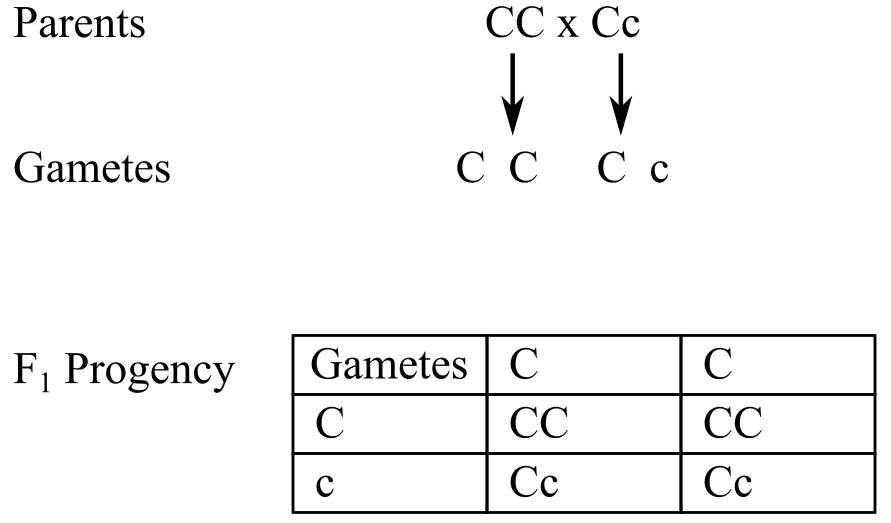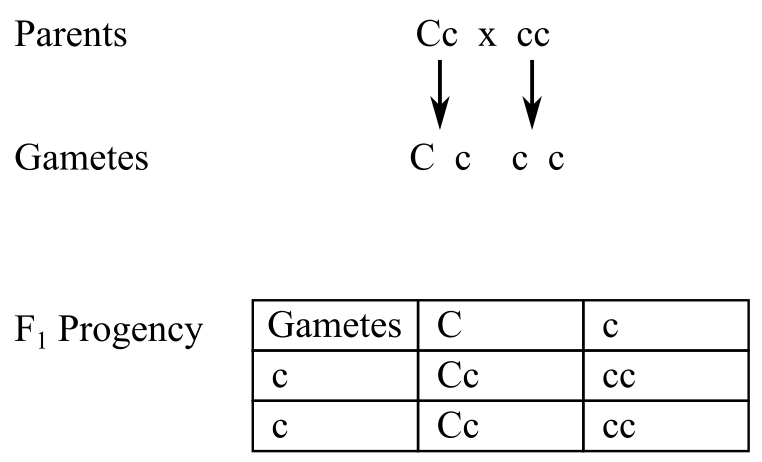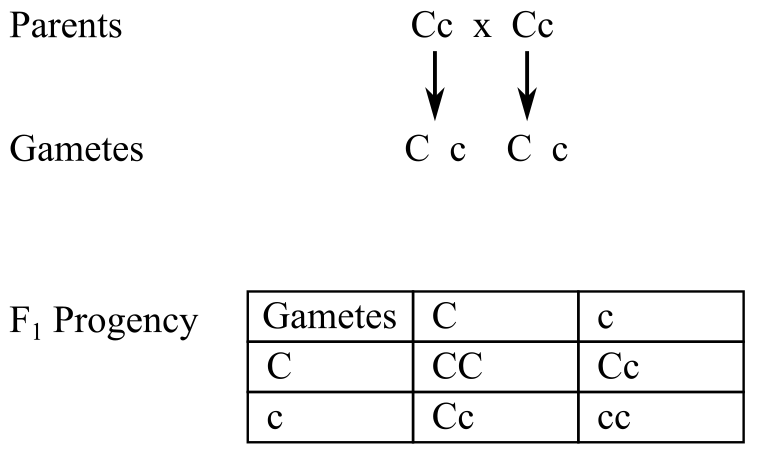
Concept explainers
The dominant C allele of a gene that controls color in corn produces kernels with color; plants homozygous for a recessive c allele of this gene have colorless or white kernels. What kinds of gametes, and in what proportions, would be produced by the plants in the following crosses? What seed color, and in what proportions, would be expected in the offspring of the crosses?
a.
b.
c.
To review:
On the basis of the data for dominant and recessive traits, the types of gametes formed, the color of the seed and its proportion, for the following crosses:
a. CC x Cc
b. Cc x cc
c. Cc x Cc
Introduction:
According to the law of dominance, the dominant trait is shown in homozygous as well as heterozygous form but the recessive trait is shown only when the homozygous allelic pair is present. The color of the kernels in corn is controlled by gene ‘C’, which is dominant in producing different colors, and gene
Explanation of Solution
a. The cross for CC × Cc can be made as follows:
The parents have the genotype CC (colored) × Cc (colored)
The cross can be made as:

All the progenies will have colored kernels.
The CC plant produces all C gametes. Cc produces 50% of C and 50% of c gametes. Looking at the offspring produced, 50% (1/2) of homozygous (CC) colored and 50% (1/2) of heterozygous (Cc) colored plants are produced.
b. The cross for Cc × cc can be made as follows:
The parents have the genotype
The cross can be made as:

The progenies have the ratio of colored kernels to white kernels as
The Cc plant produces 50% of C and 50% of c gametes and the cc parent produces all c gametes. Looking at the offspring produced, 50% (1/2) of heterozygous (Cc) colored plants and 50% (1/2) of homozygous recessive plants are produced.
c. The cross for Cc × Cc can be made as follows:
The parents have the genotype Cc (colored) and Cc (colored).
The cross can be made as:

The progenies have the ratio of colored kernels to white kernels as
Both the Cc plants produce 50% of C and 50% of c gametes. Looking at the offspring produced, 50% (1/2) of heterozygous (Cc) colored plants, 25% (1/4) of homozygous recessive plants, and 25% (1/4) of homozygous colored plants are produced.
Therefore, it can be concluded that:
a. Cc produces 50% of C and 50% of c gametes. Half of homozygous (CC) colored and halh of heterozygous (Cc) colored plants are produced.
b. Cc produces 50% of C and 50% of c gametes and cc produces all c gametes. Half of heterozygous (Cc) colored plants and half of homozygous recessive plants are produced.
c. Both the Cc plants produce 50% of C and 50% of c gametes. Half of heterozygous (Cc) colored plants, 1/4 of homozygous recessive plants, and 1/4 of homozygous colored plants are produced.
Want to see more full solutions like this?
Chapter 12 Solutions
Biology: The Dynamic Science (MindTap Course List)
- Imagine that you are performing a cross involving seed texture in garden pea plants. You cross true-breeding round and wrinkled parents to obtain F1 offspring. Which of the following experimental results in terms of numbers of plants are closest to what you expect in the F2 progeny? a. 8lOroundseeds b. 8lOwrinkledseeds c. 405:395 round seeds:wrinkled seeds d. 610:190 round seeds:wrinkled seedsarrow_forwardA diploid plant is heterozygous for two linked genes, A and B. Crossovers between the two genes occurs in ~10% of meiosis. Multiple crossovers are never observed in one cell undergoing meiosis. What fraction of the gametes produced by this diploid plant are expected to be recombinant type? O 5% O 10% 2.5% 25%arrow_forwardGiven the following pathway on the image: G and H are dominant alleles of the two independently assorting genes that produce an enzyme that catalyzes the conversion of one pigment to another, and g and h are recessive alleles that are non-functional. A true-breeding blue plant is crossed with a white plant of genotype ggHH. The F1s are allowed to self-mate. 1. What proportions would you expect in the F2 progeny? 2. Which is the epistatic allele?arrow_forward
- A type of tomato (Solanum lycopersicum) produces fruit in three possible colors: red, green, and orange. You cross a true-breeding orange-fruited plant with a true-breeding green-fruited plant, and all the F1 offspring are red. You intercross the red F1s, and the resulting F2 generation consists of 108 red-, 40 orange-, and 44 green-fruited plants. 1) What type of epistasis is acting (dominant, recessive, duplicate dominant, or duplicate recessive)? 2) Assign the phenotypes to a modified 9:3:3:1 ratio. (Do not just calculate the actual ratio of the phenotypes.) Red : _____Orange : _____Green: _____arrow_forwardIn a variety of tomato plant ,the leaves maybe pure green,pure white,or variegated (mixture). a)when 2 variegated plants were crossed,87 offspring were produced,of these 20 were green,46 were variegated and 21 remain died soon after germination.Draw a genetic diagram to explain these results,why did 21 of them diedarrow_forwardIn sweet peas, the synthesis of purple anthocyanin pigment in the petals is controlled by two genes, B and D. What petal color would you expect in a pure breeding plant unable to catalyze the first reaction? Indicate the genotype and phenotype. 2. What petal color would you expect in a pure breeding plant unable to catalyze the second reaction? Indicate the genotype and phenotype. 3. If plants 1 and 2 are crossed, what petal color would the F1 plants have? Indicate the genotype and phenotype. 4. What ratio of purple : blue : white plants would you expect in the F2? Indicate the genotypes, phenotypes, and the F2 phenotypic ratio.arrow_forward
- SET 2: In corn, the following allelic pairs have been identified in chromosome 3: +/b plant color booster vs. non-booster +/lg with ligule vs. without ligule +/v green plant vs. virescent A test cross between triple recessive plants and plants heterozygous for the three pairs gave the following progeny: + v lg 305 b + lg b v lg + + lg b v + 148 58 + + + 62 + y + 152 b + + 275 Total 1000 Calculate the parental and recombinant frequencies, the map distances between genes, and the coefficient of coincidence. Illustrate the gene map or sequence.arrow_forwardSET 2: In corn, the following allelic pairs have been identified in chromosome 3: +/b > plant color booster vs. non-booster +lg → with ligule vs. without ligule +/v > green plant vs. virescent A test cross between triple recessive plants and plants heterozygous for the three pairs gave the following progeny: + v lg b + lg b v lg 305 148 58 + + lg b v + + + + 62 + v + 152 b + + 275 Total 1000 Calculate the parental and recombinant frequencies, the map distances between genes, and the coefficient of coincidence. Illustrate the gene map or sequence.arrow_forwardAnswer the following with a short solution if needed: a. The gametes of a worm's genotype SsYy should produce what genotypes? b. A genetic cross between two F1-hybrid rose plants having yellow petals will yield what percent green-petal plants in the F2 generation? Yellow petals are dominant to green. c. Brown fur is dominant over light-colored fur. What is the phenotype of the resulting offspring if you cross a heterozygous brown fur and a light-colored fur?arrow_forward
- For the cross: PpAa x PpAa P = purple flowers (Dominant) p = white flowers A = axial flowers (Dominant) a = terminal flowers a. What are the possible gamete classes that can form from these parents? b. What are the expected offspring genotype classes and ratios/proportions/fractions which will result from the cross? c. What are the expected offspring phenotype classes and ratios/proportions/fractions which will result from the cross? 2. Predict ratios/proportions/fractions of genotypes and phenotypes of the following crosses. T = tall stem t = dwarf stem P = purple flowers p = white flowers G = green pods g = yellow pods A = axial flowers a = terminal flowers R = round peas r = wrinkled seeds A. ttPp x Ttpp B. GgRr x ggRr C. PpGg x ppggarrow_forwardImagine that the genes for seed color and seed shape are located on the same chromosome. A cross is made between two true-breeding plants. One plant produces green wrinkled seed (rryy) and the second parent produced round yellow seeds (RRYY). A test cross is made between the F1 generation with the following results: green, wrinkled 645 green round 36 yellow wrinkled 29 yellow round 590 a) Draw the chromosomes of parents and four types of offsprings and show the recombinant and non-recombinants in the offsprings. b) What is the recombination frequency between two loci?arrow_forwardWaxy endosperm (wx), shrunken endosperm (sh) and yellow seedling (v) are encoded by three recessive genes in corn that are linked on chromosome 5. A corn plant homozygous for all three recessive alleles is crossed with a plant homozygous for all the dominant alleles. The resulting F1 are then crossed with a plant homozygous for the recessive alleles in a three point test cross. The progeny of the test cross are: wx sh WX SH V WX SH V Wx sh WX sh V SH v SH V V 87 1,515 94 WX 1,531 3,479 292 WX Wx sh v 3,478 280 a. Determine the order of the genes on the chromosome. b. Calculate the map distances between the genes. c. Determine the cc and I.arrow_forward
 Concepts of BiologyBiologyISBN:9781938168116Author:Samantha Fowler, Rebecca Roush, James WisePublisher:OpenStax College
Concepts of BiologyBiologyISBN:9781938168116Author:Samantha Fowler, Rebecca Roush, James WisePublisher:OpenStax College
